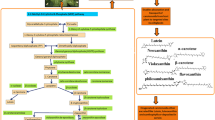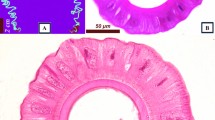Abstract
By using silkworms, Bombyx mori, fluorescent cocoon sex identification (FCSI) as an experimental material, direct fluorescence spectrometry of the cocoon surface indicates that the fluorescent color of silkworm cocoons is made up of two peaks of yellow and blue-purple fluorescence emission. The fluorescent difference between male and female cocoons is attributed to the differential absorption of yellow fluorescent substances by the midgut tissue of 5th instar female silkworms. Thin layer chromatography (TLC) and fluorescent spectra indicate that blue-purple fluorescent substances are composed of at least five blue-purple fluorescent pigments, and yellow fluorescent substances are made up of at least three. UV spectra and AlCl3 color reaction show that the three fluorescent yellow pigments are flavonoids or their glycosides. Silkworm FCSI is due to selective absorption or accumulation of the yellow fluorescent pigments by the posterior midgut cells of female 5th instar larvae. The cells of the FCSI silkworm midgut, especially the cylinder intestinal cells of the posterior midgut have a component which is a yellow fluorescent pigment-specific binding protein that may be vigorously expressed in the 5th instar larvae.
Similar content being viewed by others
References
Oku M. The chemical studies on the pigments in the cocoon filaments of Bombyx mori (VII) (in Japanese). Nippon Nogeikagaku Kaishi, 1934, 10: 1014–1028 1:CAS:528:DyaA2MXht1yjtQ%3D%3D
Oku M. Studies on cocoon pigment in the silkworm, Bombyx mori (VIII) quercetin glycosides in mulberry leaves (in Japanese). Nippon Nogeikaguku Kaishi, 1934, 10: 1029–1038 1:CAS:528:DyaA2MXht1yjuw%3D%3D
Xiang Z H, Huang X Z, Xia Q Y. Genetic analysis on cocoon fluorescent colour in Bombyx mori. Acta Sericologica Sin, 1997, 23: 87–91
Liu A H, Chen K P. Studies on the RAPD markers for fluorescent color of cocoon in silkworm (Bombyx mori) using RAPD method, J Anhui Agricult Univ, 2005, 32: 490–492 1:CAS:528:DC%2BD28XisFeisr8%3D
Yu X H. Several production methods of the male silkworm silk (in Chinese). Jiangsu Sericult, 2003, 2: 80–81
Sericulture Department of South China Agricultural College, Breeding of sex-limited race Dong 34 (in Chinese). Guangdong Sericult, 1979, 1: 49–54
Liu J Q, Yu Z C, Cui Y M, et al. Breading of fluorescence cocoon color sex-limited varieties YingGuang and ChunYu the preparation of their F1 hybrid (in Chinese). Acta Sericologica Sin, 1996, 22: 155–159
Yu X H, Jia Z W, Yin S Q, et al. Breeding of a new silkworm variety “SuXiong×YingXiao” with sex-identified fluorescent cocoon color (in Chinese). Acta Sericologica Sin, 2008, 34: 140–143
Yu X H, Xie L Q. Studies on the inheritance of fluorescent colour of cocoons in silkworm, Bombyx mori (in Chinese). Acta Sericologica Sin, 1997, 23: 147–151
Yu X H. Sex Discrimination of Mulberry Silkworm Pod and Its Silkworm Variety Assortive Breeding Method. China Patent, CN1515150, 2004-07-28
Fujimoto N. The fluorescent color of silkworm silkgland. J Seric Sci Jpn, 1950, 19: 323–328
Yu Z C, Liu J Q, Li D Y, et al. A preliminary research on fluorescence pigment of the sex-limited fluorescence silkworm race (in Chinese). Acta Sericologica Sin, 1997, 23: 64
Lin C Q, Yao Q, Chen K P, et al. Study on fluorescence of silkworm larval blood, liquid substance in silk gland and cocoon shell (in Chinese). Acta Sericologica Sin, 1994, 20: 43–44
Yu Z C, Yokoyama T, Ninagi O, et al. Origin of yellowish fluorescent substance limited to male cocoons of race “Yoog Guang” of the silkworm, Bombyx mori. J Seric Sci Jpn, 2001, 70: 159–161
Yu Z C, Gu Y Y, Zhang F L, et al. Studies on difference of fluorescent pigment between female and male larvae of cocoon colour sex distinguished fluorescent silkworm variety (in Chinese). Acta Sericologica Sin, 2000, 26: 123–124
Fujimoto N, Kawakami K. Studies on the pigments of cocoon. (II) Genetical relationship between green cocoon and light green cocoon (Sasamayu) in the silkworm, Bombyx mori. J Seric Sci Jpn, 1958, 27: 391–392 1:CAS:528:DyaF3cXht1yjtA%3D%3D
Hayashiya K, Sugimoto S, Fujimoto N. Studies on the pigments of cocoon. (III) The qualitative test of the pigments of green cocoon. J Seric Sci Jpn, 1959, 28: 27–29 1:CAS:528:DyaF3cXhvVOmug%3D%3D
Yu Z C, Shi R C, Gu Y Y, et al. Qualitative and relative value analyses on female and male fluorescence pigment of silkworm race “YingGuang” (in Chinese). Acta Sericologica Sin, 2002, 28: 151–156 1:CAS:528:DC%2BD38XpsFansL4%3D
Chen K P, Lin C Q. Studies on the fluorescent colours of silkworm cocoons. (I) Flurorescent colours of different varieties of cocoons (in Chinese). Acta Sericologica Sin, 1988, 2: 20–25
Ajisawa A. On surface tension of sericin solution in fluorescent color cocoon layer caused. J Seric Sci Jpn, 1968, 37: 123–126 1:CAS:528:DyaF1MXjvVOguw%3D%3D
Xu H, Feng Y F. Studies on the fluorescent color, structure and properties (in Chinese). Silk, 1990, 3: 19–21
Oku M. The chemical studies of silkworm cocoon pigment (10). Japan Agricult Chem Mag, 1934, 10: 1253–1257 1:CAS:528:DyaA2MXitFCisQ%3D%3D
Hayashiya K, Sugimoto S, Fujimoto N. Studies on the pigments of cocoon. (III) The qualitative test of the pigments of green cocoon. J Seric Sci Jpn, 1959, 28: 27–29 1:CAS:528:DyaF3cXhvVOmug%3D%3D
Yu X H, Liu Y F. Difference analysis on cocoon filament quality of male cocoon and female cocoon (in Chinese). J Text Res, 2005, 26: 36–38 1:CAS:528:DC%2BD28XntlOksLc%3D
Jia Z W, Yu X H, Shen W D, et al. Primarily rearing reports on the silkworm variety “YingSu×YingXiao” with sex-identified fluorescent cocoon color (in Chinese). Jiangsu Sericult, 2004, 1: 51–53
Kurioka A, Yamazaki M. Purification and identification of flavonoids from the yellow green cocoon shell (Sasammayu) of the silkworm, Bombyx mori. Biosci Biotechnol Biochem, 2002, 55: 1396–1399 10.1271/bbb.66.1396
Onogi A, Osawa K, Yasuda H, et al. Flavonol glycosides from the leaves of Morus alba L. Shoyakugaku Zasshi, 1994, 47: 423–425
Tamura Y, Nakajima K I, Nagayasu K I, et al. Flavonoid 5-glucosides from the cocoon shell of the silkworm, Bombyx mori. Phytochemistry, 2002, 59: 275–278 1:CAS:528:DC%2BD38XhtVKgsLk%3D, 10.1016/S0031-9422(01)00477-0, 11830135
Katsube T, Imawaka N, Kawano Y, et al. Antioxidant flavonol glycosides in mulberry (Morus alba L.) leaves isolated based on LDL antioxidant activity. Food Chem, 2006, 97: 25–31 1:CAS:528:DC%2BD2MXhtlWhsbbN, 10.1016/j.foodchem.2005.03.019
Chikara H, Hiroshi O, Yasumori T, et al. Regioselective formation of quercetin 5-O-glucoside from orally administered quercetin in the silkworm, Bombyx mori. Phytochemistry, 2008, 69: 1141–1149 10.1016/j.phytochem.2007.11.009
Author information
Authors and Affiliations
Corresponding author
Rights and permissions
About this article
Cite this article
Zhang, Y., Yu, X., Shen, W. et al. Mechanism of fluorescent cocoon sex identification for silkworms Bombyx mori. Sci. China Life Sci. 53, 1330–1339 (2010). https://doi.org/10.1007/s11427-010-4084-3
Received:
Accepted:
Published:
Issue Date:
DOI: https://doi.org/10.1007/s11427-010-4084-3




